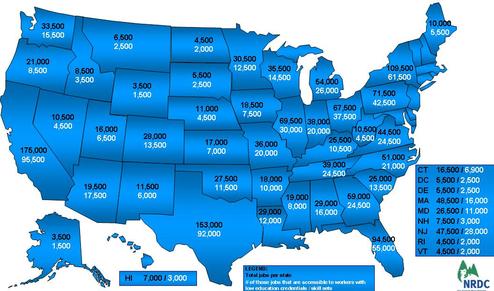 Obesity machine? The USDA released a new report on food deserts yesterday and the blogosphere lit up like a Christmas tree. Which, honestly, saves me a lot of trouble. Jill Richardson pulls out some excellent data nuggets here. To summarize: Food deserts are areas where residents lack access to supermarkets and other outlets selling a broad, range of healthy food. It turns out that only a small percentage of Americans — 2.2% — live in true food deserts. At the same time, research indicates that there’s little correlation with access to healthy food and low Body Mass Index (BMI, used as a measure of obesity).
Obesity machine? The USDA released a new report on food deserts yesterday and the blogosphere lit up like a Christmas tree. Which, honestly, saves me a lot of trouble. Jill Richardson pulls out some excellent data nuggets here. To summarize: Food deserts are areas where residents lack access to supermarkets and other outlets selling a broad, range of healthy food. It turns out that only a small percentage of Americans — 2.2% — live in true food deserts. At the same time, research indicates that there’s little correlation with access to healthy food and low Body Mass Index (BMI, used as a measure of obesity).
But I wanted to zero in on one aspect of the report that Ezra Klein captured nicely in the title of his post on the report: “It’s Not the Food We Can’t Get. It’s the Food We Can.” As he says:
The problem, it seems, is the opposite: food swamps. Areas dense with fast food and convenience stores. As the USDA puts it, “Easy access to all food, rather than lack of access to specific healthy foods, may be a more important factor in explaining increases in obesity.” The concentration of the obesity crisis in high-poverty areas thus brings us back to a pretty well-accepted hypothesis: The problem is with low-income areas where the cheap food is the bad food.
Natasha Chart at change.org then draws a line from food swamps to farm subsidies to falling incomes to obesity (a subject near and dear to my heart as well). But while I agree with Klein’s observation that:
It’s really hard to conceive of a trickier public policy problem than this one. You can solve the problem of people being unable to choose an apple and they still won’t choose an apple. People like crap food. It’s convenient. Brilliant, highly paid scientists have spent millions of dollars precisely calibrating it to the modern palette. Innovative, award-winning advertisers have spent billions of dollars making us want it. And it’s cheap.
I don’t agree with his conclusion: “I’m not sure, at this point, there are answers,” he says. Firstly, I don’t think anyone was looking at addressing food deserts as the magic bullet for the obesity epidemic. Indeed, food deserts, as highly localized problems, perhaps are best dealt with by state and local governments (not that federal dollars wouldn’t be greatly appreciated, of course). But I think there are larger policy answers, if we have the political will to enact them — and I’m not necessarily talking about farm subsidy reform.
The key is to focus on the concept of “affordability” which is, after all, relative — and not just among different incomes groups. What going on is what marketers would refer to as “competition for the consumer’s food dollar,” not to mention their time. As the USDA report observes, “Many of the stores that carry these nutritious foods at low prices also carry all the less healthy foods and beverages as well.” As a result, making good food as cheap as junk food may not be enough — the engineered products simply may overwhelm a person’s judgment (something they are designed to do, hence the name “impulse purchase”). Junk food — and that includes any processed food that crosses the line from nutritious to purely caloric — has to get more expensive. Period. The USDA report said as much when it declared that “Without also changing the dietary behaviors of consumers, interventions aimed at increasing access to healthy foods may not be successful in addressing obesity.”
Short of outlawing foods, what’s the most effective way to change behavior? Taxes, people. If nothing else, this report underscores the idea that addressing obesity and the huge threat to public health — and to the federal budget — that it represents will likely come down to sin taxes. Indeed, the USDA itself offers us a prime target: soda (or as they refer to it “sweetened beverages.”) According to the report:
Calories consumed from beverages as a portion of Americans’ total energy intake have almost doubled in the past 40 years, so much so that in 2002, 21 percent of total energy intake is from beverages (Duffey and Popkin, 2007). It is hypothesized that beverages provide less satiety than solid foods. As a result, increased calories consumed as beverages may not lead to reductions in calories from solid food and in fact may be consumed in addition to whatever calories come from solid foods leading to increased energy intake and weight gain. A summary of research suggests that beverage consumption is associated with increased energy intake, weight gain, and BMI.
On top of this effect is the fact that, according to Kate Dailey in Newsweek, as children we crave sugar more strongly than as adults. Making matters worse, sugar has an opiate-like effect on the brain. Opiate! As in opium. As in heroin. As in addiction. Not kidding:
[S]weet foods react with everyone’s brains in the same way–by producing a rush of chemicals, including dopamine, which creates an opiate-like effect. “In Sweden, sweet-tasting foods like sugar solutions are used as anesthetic to do minor surgeries,” says Dr. Kampov-Polevi. Sugar water is also used in the US on babies for minor procedures like blood draws. It’s also a go-to staple for recovering addicts, who find that binging on sugary snacks can sometimes help fight the urge to drink.
Dailey includes the observation by Barry Popkin, nutrition expert at UNC (whose research in referenced in the USDA report) that “An increase in sugary beverages has translated into a two-thirds to three-fourths increase in overall calorie consumption over the last 20 years.”
Well, yeah. That’s the obesity epidemic right there. And that’s the policy angle, folks. Start with soda — make it so that low-income people don’t serve it as the top drink at home (it’s cheaper by volume than any juice or milk). The feds may not have the cojones to do it — it’s a problem, as the NYT recently observed, when the top two politicians on the Senate Finance Committee are Max Baucus of sugarbeet-happy Montana and Chuck Grassley of corn/HFCS-happy Iowa. But localities may yet take the lead — like Nassau County on Long Island in NY that’s trying to enact a tax on fast-food restaurants (via GastroNomalies).
The point is that we know what the point is. Too many Americans are calorie rich and nutrient poor. When much of the ag and food policy regime was created mid-century, all we knew was to throw calories at people fortified with a half-dozen or so essential vitamins and minerals. We turned out to be really really good at that. But the processed food companies took over the game and started making stuff that was worse and worse for us at lower and lower prices. The USDA, in its own quiet way, just confirmed all that. So are we going to do something about it or not?



